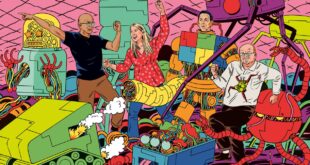At this point, phrases like ambient computing, ubiquitous computing, and even (shudder) Internet of Things may be zipping and popping around your brain. Are we back here again? If the answer is yes, it might not be a reason to despair. Béhar cites Embodied’s Moxie companion robot, ElliQ’s elder care, and the Happiest Baby robotic bassinet as examples of AI-powered devices which actually “solve specific human needs”—but it should be noted Béhar is involved in all these products. He says, “We are designing these experiences to be directly embedded into the actual physical element of these products, rather than your smartphone. This lightens the reliance to do everything on a personal device, and we find that these solutions are not socially disruptive and actually more magical in their use.”
Just last week, Sir Jonathan Ive was handing out degrees to Royal College of Art and Imperial College graduates at the Royal Festival Hall ceremony in London, as befitting his role as an elder statesman of design. Stephen Green, head of the joint Innovation Design Engineering program between the two universities, suggests that Ive is the perfect candidate to scoop up and metabolize all the post-smartphone, post-screen experiments we’ve seen come and go over the past decade, whether that’s voice agents—which Green believes needs to be used in combination, not solo—wearables, Bluetooth beacons for greater fidelity at a location level, signal processing, olfactory sensors (OK, perhaps we’re not quite ready for that last one).
“Historically speaking, that was the beauty of Apple with Steve Jobs,” says Green. “Ultimately a marketing person with great technological foresight, and able to, with what’s sometimes referred to as design leadership, bring an amazing team of people and investors around him to make that happen. So, obviously, Jony Ive has many of those ingredients that are needed, with the backing that can coalesce around him, to achieve amazing critical mass to do something innovative. Because a lot of the technology and possibility is out there.”
The iPhone of AI
The original rumors and reports referred, of course, to an “iPhone of AI,” in the sense of a super successful device that allows everyday people to access cutting-edge technology. It’s likely that the dominant component in any era-shaping system cooked up by LoveFrom and OpenAI will define itself against the iPhone. The mentions of social disruption and reliance on screens do chime with Ive’s somewhat elusive comments through the years on smartphones and social media addiction.
Ive is on record as saying he has limited his children’s screen time. When pressed by Anna Wintour on stage at the WIRED25 Summit in 2018 as to whether we are now “too connected,” he responded: “The nature of innovation is that you cannot predict all the consequences. In my experience, there have been surprising consequences. Some fabulous, and some less so.”
One possible kindred spirit, both in terms of breaking away from smartphone norms and San Francisco culture, is Anjan Katta, the founder of Daylight, whose DC-1 tablet goes against the grain with a 60-fps paperlike display. He says that the harmful components of our current consumer tech, including blue light, flicker, and addiction-inducing notifications, can make us sicker and more anxious. “As someone who has directly experienced the extreme downsides of modern technology, including eye strain, disrupted circadian rhythm, exacerbation of ADHD symptoms, and mental health concerns like anxiety and depression,” he says, “I wholeheartedly embrace the push to create personal computing devices that don’t consume such a large share of our time and energy.”
Source link
 meganwoolsey Home
meganwoolsey Home



